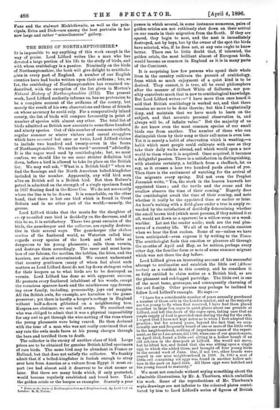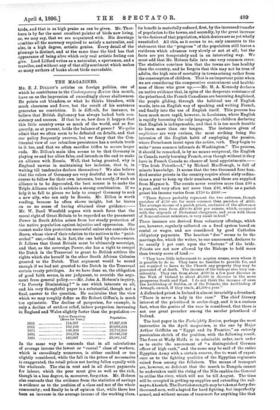THE BIRDS OF NORTHAMPTONSHIRE.*
IT is impossible to say anything of this work except in the way of praise. Lord Lilford writes like a man who has devoted a large portion of his life to the study of birds, and with whom ornithology is a passion. Nominally on the birds of Northamptonshire, the book will give delight to ornitholo- gists in every part of England. A number of our English counties have had books written upon their avifauna ; but, so far, the ornithology of Northamptonshire has remained un- described, witk the exception of the list given in Morton's Natural History of Northamptonshire (1712). The present work, Lord Lilford modestly informs us, has no pretension to be a complete account of the avifauna of the county, but merely the result of his own observations and those of friends on whose accuracy be could rely. For a comparatively inland county, the list of birds will compare favourably in point of number of species with almost any other. The total list of birds admitted as British now amounts to some three hundred and ninety species. Out of this number of common residents, regular summer or winter visitors and casual stragglers which have occurred but once or twice, Lord Lilford claims to include two hundred and twenty-seven in the fauna of Northamptonshire. We use the word " occurred " advisedly. It is the vague word used by ornithologists; but, we must confess, we should like to see some stricter definition laid down, before a bird is allowed to take its place on the British list. We may well ask, " What is a British bird? " when we find the flamingo and the North American belted-kingfisher included in the number. Apparently, any wild bird seen alive on British soil is a British bird. But then Bulwer's petrel is admitted on the strength of a single specimen found in 1837 floating dead in the River Ure. We do not see exactly where the line is to be drawn. It is remarkable, ou the other hand, that there is but one bird which is found in Great Britain and in no other part of the world,—namely, the grouse.
Lord Lilford thinks that the mania for the slaughter of cvt ry so-called rare bird is decidedly on the decrease, and if this be so, it is satisfactory. Those two great enemies of the birds, the gamekeeper and the collector, are equally destruc- tive in their several ways. The gamekeeper (the cholera morbus of the feathered world, as Waterton called him) regards every species of the hawk and owl tribe as dangerous to his young pheasants ; calls them vermin, and destroys them accordingly. The rarer and most harm- le3s of our falcons, the merlins, the hobbies, the kites, and the karriers, are almost exterminated. We cannot understand that country gentlemen (many of whom feel about such matters as Lord Lilford does) do not lay down stringent rules for their keepers as to what birds are to be destroyed as vermin. Lord Lilford has done so with apparent success. He protects every feathered inhabitant of his woods, except the voracious sparrow-hawk and the mischievous egg-devour- ing crow family, including, presumably, jays and magpies. All the British owls, for example, are harmless to the game- preserver ; yet there is hardly a keeper's cottage in England without half-a-dozen gibbetted on a neighbouring tree. Keepers are obstinate, we are well aware. We recollect one who was obliged to admit that it was a physical impossibility for any owl to get through the wire-netting of the runs where the young pheasants were being reared. He then declared with the tone of a man who was not really convinced that at any rate the owls made faces at his young charges through the bars and terrified them to death.
The collector is the enemy of another class of bird. Large prices are to be obtained for genuine British killed specimens of rare birds. The same bird may be abundant in France or Holland, but that does not satisfy the collector. We frankly admit that if a belted-kingfisher is foolish enough to stray over here from America or a vulture from Egypt it must ex- pect (we had almost said it deserves) to be shot sooner or later. But there are many birds which, if only protected, would become regularly established and breed here. Take the golden oriole or the hoopoe as examples. Scarcely a year
• Note, on the Birds of Nmihamptonehir• and Neighbourhood. By Lord IAlf rd. London: B. IL Porter.
passes in which several, in some instances numerous, pairs of golden orioles are not ruthlessly shot down on their arrival on our coasts in their migration from the South. If they are spared, they begin to nest, and the nest is immediately destroyed, not by boys, but by the owner of the spot the birds have selected, who, if he does not, at any rate ought to know better. There can be little doubt that, if tolerated, the golden oriole, the most brilliant almost of European birds, would become as common in England as it is in many parts of the Continent.
It is surprising how few persons who spend their whole lives in the country cultivate the pursuit of ornithology, from which so much enjoyment of a quiet kind is to be derived. They cannot, it is true, all be rural philosophers after the manner of Gilbert White of Selborne, nor pos- sibly contribute much that is new to ornithological knowledge. But Lord Lilford writes :—" I have more than once heard it said that British ornithology is worked out, and that there remains no more to be done therein; but this I emphatically deny, and maintain that we have much to learn on the subject, and that accurate personal observation is, and always will be, of infinite value." But the majority of us do not know even the most common species of our small birds one from another. The number of those who can distinguish them by their song or their call-notes is even less. Yet it is merely a habit of observation which is wanting,—a habit which most people could cultivate with ease as they take their daily walks abroad, and which would open a new world to them when it is acquired. Once acquired, it becomes a delightful passion. There is a satisfaction in distinguishing, with absolute certainty, a bullfinch from a chaffinch, let us say, as it crosses a lane two hundred yards ahead of you.
Then there is the excitement of watching for the arrival of the migrants every spring. Did not even the Prophet Jeremiah write, " Yea, the stork in the heaven knoweth her
appointed times ; and the turtle and the crane and the swallow observe the time of their coming." Eagerly does the ornithologist await the time of their coming, and note whether it really be the appointed time or earlier or later.
An hour's waiting with a field-glass under a tree is amply re- warded by the satisfaction of decidedly determining whether the small brown bird (which most persons, if they noticed it at
all, would set down as a sparrow) be a willow-wren or a wood- warbler. Let not the reader smile; such are the real plea- sures of a country life. We all of us feel a certain emotion when we hear the first cuckoo. Some of us—unless we have been anticipated—even express it by writing to the Times.
The ornithologist feels this emotion or pleasure all through the months of April and May, as he notices, perhaps every other day, the familiar form or note of some summer migrant which was not there the day before.
Lord Lilford gives an interesting account of his successful attempt to acclimatise and establish the little owl (Athena stoctua) as a resident in this country, and he considers it as fully entitled to claim notice as a British bird, as are
the pheasant and red-legged partridge. The little owl is one of the most tame, grotesque, and consequently charming of the owl family. Other persons may perhaps be inclined to follow Lord Lilford's example. He says :—
" I have for a considerable number of years annually purchased a number of these owls in the London market, and as the majority are too young to fly when first received, I have had them placed together in large box cages in quiet places about our grounds at Lilford, and left the doors of the cages open, taking care that an ample supply of food is provided once during the day for the owls. I regret that I have not kept notes as to when I first adopted this practice ; but for several years, beyond the fact that we occa- sionally saw and frequently heard of one or more of the little owls in the neighbourhood, nothing of importance came of the experi- ment, so far as I aut aware, till 1589, when one of our gamekeepers, on April 23rd, found a little owl sitting in a hollow bough of an old ash-tree in the deer-park at Lilford. She would not move, but he lifted her, and found that she was sitting upon a single egg, to which she added three, and brought off four young birds in the second week of June. One, if not two, other broods were reared in our near neighbourhood in 1889. In 1S9J a nest of little owl containing six eggs was found in another hollow ash- tree in the park on April 25th. All these eggs were hatched and the young reared to maturity."
We must not conclude without saying something about the admirable illustrations, by Mr. A. Thorburn, which embellish the work. Some of the reproductions of Mr. Thorburn's sepia-drawings are not inferior to the coloured plates contri- buted by him to Lord Lilford's series of figures of British birds, and that is as high praise as can be given. Mr. Thor- burn is by far the most excellent painter of birds now living, or, we may say, that we are acquainted with. His drawings combine all the accuracy required to satisfy a naturalist, and also, in a high degree, artistic genius. Every detail of the plumage is distinct, and at the same time the bird has that appearance of being alive which only real artistic feeling can give. Lord Lilford writes as a naturalist, a sportsman, and a traveller, and without any of that silly sentiment which makes so many authors of books about birds unreadable.



































 Previous page
Previous page